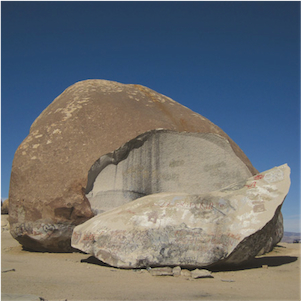For two eccentric Californians, Frank Critzer and George Van Tassel (who went on to build the Integratron rejuvenation machine nearby based on ET guidance), the immense girth of Giant Rock was not simple geological happenstance but a sign portending mystical significance. In the hands of these two men, Giant Rock became the locus of a strange episode in the twentieth-century history of the American West. Like all Western heroes, Critzer and Van Tassel felt themselves poised between worlds, and at the threshold of civilization. Both felt vitalized and validated by the rock, and both saw it as a natural hub, laboring for decades to make it a gathering place. Absolutely inert and yet fecund, Giant Rock was less a rock than a destiny.
There is little trace of this history at the rock itself, except for a dusty slab of concrete. The concrete conceals a cavern, built by Critzer as a home, and later used by Van Tassel for telecommunication sessions with aliens. No one knows how Critzer stumbled on Giant Rock in the 1930s, or why he decided to move there, but he was obviously clever and resourceful. Critzer saw that the rock’s immense shadow offered succor from the heat and, following the lead of desert tortoises that dig holes in the sand in which to cool themselves, he used dynamite to blast out an abode beneath its north face. Engineering a rainwater-collection system and a narrow tunnel for ventilation, the home he excavated was never warmer than eighty degrees Fahrenheit and never cooler than fifty-five. Perfectly suited to its site, Critzer’s abode refuted the paradigmatic inhospitality of the desert.
Welcome to ...
The place where the world comes together in honesty and mirth.
Windmills Tilted, Scared Cows Butchered, Lies Skewered on the Lance of Reality ... or something to that effect.
Windmills Tilted, Scared Cows Butchered, Lies Skewered on the Lance of Reality ... or something to that effect.
Sunday, October 26, 2014
The world's biggest boulder, UFOs, and the weird American West
Cabinet Magazine's Sasha Archibald cracks open the cultural mystique of the Mojave Desert's Giant Rock, considered the largest boulder in the world until 2000 when a chunk fell off.
From Cabinet:
Subscribe to:
Post Comments (Atom)


No comments:
Post a Comment